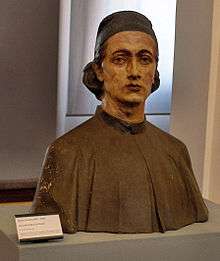Giovanni di Bicci de' Medici
| Giovanni de' Medici | |
|---|---|
 Portrait by Cristofano dell'Altissimo. | |
| Born |
1360 Florence, Republic of Florence |
| Died |
20 February 1429 (aged 69) Florence, Republic of Florence |
| Noble family | Medici |
| Spouse(s) | Piccarda Bueri |
| Issue | |
| Father | Averardo de' Medici |
| Mother | Jacopa Spini |
Giovanni di Bicci de' Medici (c. 1360 – 20/28 February 1429) was an Italian banker and founder of the Medici Bank. While other members of the Medici family, such as Chiarissimo di Giambuono de' Medici, who served in the Signoria of Florence in 1201, and Salvestro de' Medici, who was implicated in the Ciompi Revolt of 1378, are of historical interest, it was Giovanni's founding of the family bank that truly initiated the family's rise to power in Florence.[1] He was the father of Cosimo de' Medici (Pater Patriae), the first Medici ruler of Florence, and an ancestor of other notable Medici rulers, for example, the grandfather of Piero di Cosimo de' Medici; great-grandfather of Lorenzo de' Medici (the Magnificent); and great-great-great-grandfather of Cosimo I de' Medici, Grand Duke of Tuscany.
Biography
Giovanni di Bicci de' Medici was born in Florence, the son of Averardo de' Medici and Jacopa Spini. Though he is considered the founder of the prosperous Medici dynasty, he was not born into a wealthy family. The little money left by his father at his death in 1363 was divided between a widow and five sons, leaving Giovanni with little.
Giovanni was somewhat uninterested in politics, unless the issues pertained to his family or bank. Often, when his name was put forward to participate in the Florentine government, he usually chose to pay a fine rather than serve. Nonetheless, he did serve as a Priore in the Signoria in 1402, 1408 and 1411 and as a Gonfaloniere for the statutory two-month period in 1421.[2] In 1402, he served as one of the judges on the panel that selected Lorenzo Ghiberti's design for the bronzes on the doors to the Florence Baptistery.[3]
Giovanni owned two wool workshops in Florence and was a member of two guilds: the Arte della Lana and the Arte del Cambio.[4] The Medici family bank he founded in 1397, his main commercial interest, had branches throughout the northern Italian city-states and beyond, and constituted an early "multi-national" company. In 1414, Giovanni bet on the permanent return of the papacy to Rome after a long period of exile and schism, and was correct; the papacy was permanently installed in Rome in 1417 under a single pope after the deliberations of the Council of Constance. Rewarding Giovanni for his support, Pope Martin V gave Giovanni's general manager control of the Apostolic Chamber.[5] Subsequent popes also made use of the services of the Medici banks, and in addition, Giovanni was able to secure tax-farming contracts and the rights to many alum mines from the papacy. He set his family on the path to becoming one of the richest dynasties in Europe, thereby making an essential stride towards its later cultural and political prominence. One way in which he laid the groundwork for this was by marrying Piccarda Bueri, whose old and respectable family brought him a large dowry.[6]
When he died, he was one of the richest men in Florence, as shown by his tax report of 1429.[7] In 1420, Giovanni had given the majority of control of the bank to his two sons, Cosimo and Lorenzo.[8] Upon his death in 1429, he was buried in the Old Sacristy of the Basilica of San Lorenzo, Florence,[9] and his wife was buried with him after her death four years later.

Fictional Depictions
Giovanni de' Medici is portrayed by Dustin Hoffman in the 2016 television series Medici: Masters of Florence.[10]
Children
- Cosimo di Giovanni de' Medici
- Damiano di Giovanni de' Medici
- Lorenzo di Giovanni de' Medici
References
- ↑ Grendler et al. S. v. "Medici, House of."
- ↑ Hibbert, 32.
- ↑ Parks, 8.
- ↑ Hibbert, 33.
- ↑ Grendler et al. S. v. "Medici, Cosimo de.’"
- ↑ Pernis & Adams 2006, p. 8
- ↑ Grendler et al S. v. "Medici, Cosimo de.’"
- ↑ Grendler, et al. S. v. "Medici, Cosimo de.’"
- ↑ Pernis & Adams 2006, p. 9
- ↑ "Medici: Masters of Florence". Internet Movie Database. Retrieved 24 December 2016.
External links
- PBS - Medici: Godfathers of the Renaissance
- THE MEDICI Genealogical tree from Florence Art Guide - The Renaissance
- Medici Family from The Galileo Project
- Image of Medici family tree
Sources
- Grendler, Paul F., M. J. B. Allen, William R. Bowen, Margaret L. King, Stanford E. Lehmberg, Nelson H. Minnich, Sara T. Nalle, Robert J. Rodini, Ingrid D. Rowland, David B. Ruderman, Erika Rummel, J.H.M. Salmon, and William A. Wallace, O.P., eds. (1999). Encyclopedia of the Renaissance. Charles Schribner's Sons, New York, New York.
- Hibbert, Christopher (1975). The House of the Medici: Its Rise and Fall. William Morrow & Company, Inc. New York.
- Parks, Tim (2005). Medici Money: Banking, Metaphysics, and Art in Fifteenth-Century Florence. W.W. Norton & Company. New York. London.
- Pernis, Maria Grazia and Adams, Laurie (2006). Lucrezia Tornabuoni de' Medici and the Medici family in the fifteenth century. Peter Lang Publishing, Inc, New York.
